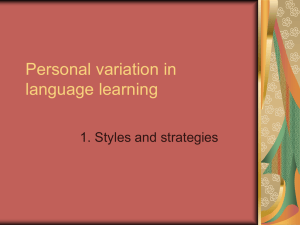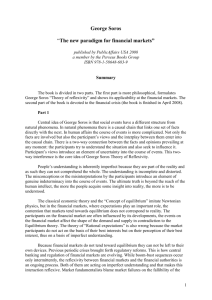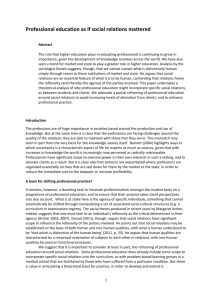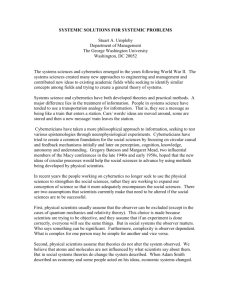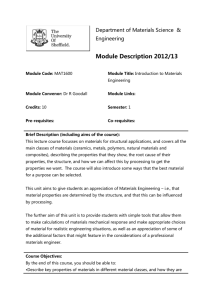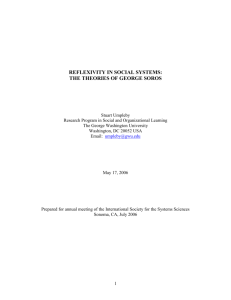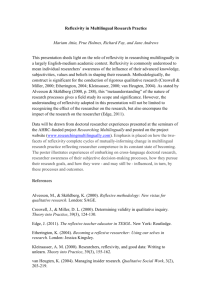Complexity to Reflexivity - The George Washington University
advertisement
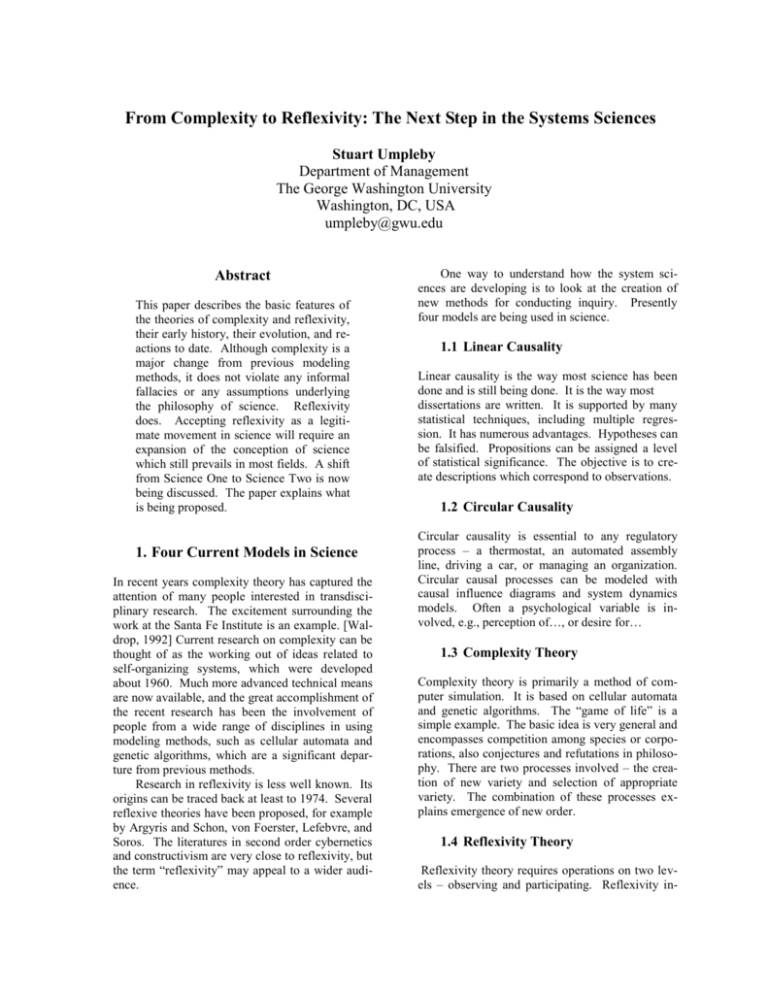
From Complexity to Reflexivity: The Next Step in the Systems Sciences Stuart Umpleby Department of Management The George Washington University Washington, DC, USA umpleby@gwu.edu Abstract This paper describes the basic features of the theories of complexity and reflexivity, their early history, their evolution, and reactions to date. Although complexity is a major change from previous modeling methods, it does not violate any informal fallacies or any assumptions underlying the philosophy of science. Reflexivity does. Accepting reflexivity as a legitimate movement in science will require an expansion of the conception of science which still prevails in most fields. A shift from Science One to Science Two is now being discussed. The paper explains what is being proposed. 1. Four Current Models in Science In recent years complexity theory has captured the attention of many people interested in transdisciplinary research. The excitement surrounding the work at the Santa Fe Institute is an example. [Waldrop, 1992] Current research on complexity can be thought of as the working out of ideas related to self-organizing systems, which were developed about 1960. Much more advanced technical means are now available, and the great accomplishment of the recent research has been the involvement of people from a wide range of disciplines in using modeling methods, such as cellular automata and genetic algorithms, which are a significant departure from previous methods. Research in reflexivity is less well known. Its origins can be traced back at least to 1974. Several reflexive theories have been proposed, for example by Argyris and Schon, von Foerster, Lefebvre, and Soros. The literatures in second order cybernetics and constructivism are very close to reflexivity, but the term “reflexivity” may appeal to a wider audience. One way to understand how the system sciences are developing is to look at the creation of new methods for conducting inquiry. Presently four models are being used in science. 1.1 Linear Causality Linear causality is the way most science has been done and is still being done. It is the way most dissertations are written. It is supported by many statistical techniques, including multiple regression. It has numerous advantages. Hypotheses can be falsified. Propositions can be assigned a level of statistical significance. The objective is to create descriptions which correspond to observations. 1.2 Circular Causality Circular causality is essential to any regulatory process – a thermostat, an automated assembly line, driving a car, or managing an organization. Circular causal processes can be modeled with causal influence diagrams and system dynamics models. Often a psychological variable is involved, e.g., perception of…, or desire for… 1.3 Complexity Theory Complexity theory is primarily a method of computer simulation. It is based on cellular automata and genetic algorithms. The “game of life” is a simple example. The basic idea is very general and encompasses competition among species or corporations, also conjectures and refutations in philosophy. There are two processes involved – the creation of new variety and selection of appropriate variety. The combination of these processes explains emergence of new order. 1.4 Reflexivity Theory Reflexivity theory requires operations on two levels – observing and participating. Reflexivity in- volves self-reference, hence paradox, hence inconsistency. Reflexivity violates three informal fallacies – circular arguments, the ad hominem fallacy, and the fallacy of accent (referring to two levels of analysis at one time). organized by its environment, not by itself. He described three thought experiments to explain his conception of “order from noise.” The thought experiments, about magnetic cubes in a box, show that as a system goes toward its equilibrial states, it can produce new combinations of elements. Some of the combinations are interesting. Some are not. For example, some new companies succeed; others fail. The box with the magnetic cubes is open to energy. Shaking the box provides energy. The box is also closed to information. That is, during each experiment the interaction rules among the cubes do not change. For the first two experiments the results are not surprising and are not interesting. In the third experiment new “order” emerges. The idea that life exists at the “edge of chaos” is similar to von Foerster’s three thought experiments concerning magnetic cubes. Furthermore, von Foerster suggested that “redundancy” in Shannon’s [1949] information theory could be used to measure amount of organization. At about the same time Ross Ashby wrote an article “Principles of the Self-Organizing System.” In this article Ashby [1962] noted, “any isolated, determinate, dynamic system obeying unchanging laws will develop organisms that are adapted to their environments.” In Ashby’s conception organisms and their environments, taken together, constitute the self-organizing system. Imagine a system composed of states. Some states are stable. Some are not. The system will tend to move toward the stable equilibrial states. As it does so, it selects, thereby organizing itself. These selections constitute self-organization. Hence, every system as it goes toward equilibrium organizes itself. As an example of self-organization Ashby described a thought experiment. Imagine that the memory locations in a computer are filled with the single digit numbers 0 to 9. Take any two numbers at random. Multiply them, replace the first number with the right hand digit of the product. Return the second number to its original position. Perform this operation repeatedly. As the interaction rule operates, the evens drive out the odds. An even times an even gives an even; an even times an odd gives an even; and an odd times an odd gives an odd. Furthermore, the zeros drive out their fellow evens. If one applies Shannon’s redundancy measure to the numbers at each point in time, redundancy increases from zero to one. As the system goes to equilibrium, it selects, thereby organizing itself. 2. A Further Explanation of Complexity Theory What is currently called complexity theory can be seen as an extension of the work on self-organizing systems around 1960. [Ashby, 1962; von Foerster, 1962] There are two processes – differentiation or the creation of new variety and selection of appropriate variety. The first occurs within an organism or organization; the second occurs in the environment. The basic structure of thinking underlying selforganization is not new. Adam Smith [1776] used the idea in The Wealth of Nations when he described the process of innovation and competition among firms or nations. Charles Darwin [1859] used the idea when describing genetic mutation and selection by the environment. Karl Popper [1962] used the idea in philosophy when he described conjectures and refutations as the means whereby science progresses. Some other versions of the idea are B.F. Skinner’s [1938] concept of operant conditioning in that behaviors are reinforced or not by the environment of an organism, thus altering their frequency. Donald T. Campbell [1969] in a famous article, “Reforms as Experiments,” used the idea when suggesting a strategy of political and social development by inventing and passing social reforms and then observing whether they produce the desired results. The concept of self-organization emerged in the field of cybernetics in the late 1950s. The question then was, as phrased by Ashby [1952], “Can a mechanical chess-player outplay its designer?” Or, stated differently, should an artificial intelligence device be told how to operate or should it learn on its own? Learning on its own was called “self-organization.” Engineers chose to design equipment and created the field of artificial intelligence. Cyberneticians chose to study learning and cognition. Three conferences on self-organization were held in the period 1960 to 1962. [Yovits, Jacobi and Goldstein, 1962] The original conception was that a self-organizing system interacted with its environment. Von Foerster [1962] opposed this conception, saying that such a system would be 2 3. The Use of the Concept of SelfOrganization in Management The principle of self-organization provides a general design rule – in order to change any system, expose it to an environment such that the interaction between the system and its environment moves the system in the desired direction. This conception can explain chemical processes such as making steel from iron ore and coke, educating a child by sending it to school, a manager providing incentives for improved performance, or the government regulating the behavior of businesses. Ashby’s conception of self-organization, that organisms and environments together constitute a self-organizing system, is a very general theory. It encompasses Darwin’s theory of natural selection and learning theory. It emphasizes the selection process rather than the generation of new variety. Von Foerster’s thought experiment explains “emergence” because selection at a lower level can lead to new variety at a higher level. The von Foerster and Ashby thought experiments illustrate how emergence of something new and the tendency toward greater entropy occur simultaneously. Ashby’s notion of self-organization requires a new conception of a system, one that is open to energy but closed to information. This idea is different from earlier conceptions of open and closed systems. Often “open” means receptive to new information. “Closed” can mean not open to new information; rigid, unchanging, dogmatic. In physics entropy increases in thermodynamically closed systems. In biology living systems are open to matter/energy and information. [Miller, 1978] In management there was a change from closed conceptions (focusing on processes within a firm) to open conceptions after World War II. Companies were seen as being influenced by government regulation, the civil rights movement, the women’s movement, etc. The concept of self-organization can be used to understand and to design incentive systems, advertising campaigns, and government regulation of business. These are just a few examples of how the concept of self-organization is used every day in business, though the idea is rarely named. second an observer creates a mental model of himself observing an object or process. See Figure 1. So far science has chosen the first conception. In classical science the objective was to remove the observer from the domain of observation. This was done in an effort to create objective, unbiased observations. Also, including the observer in the domain of observation is an example of selfreference. Self-reference leads to paradox, which is a form of inconsistency. Hence, the second conception of observation leads to ambiguity and uncertainty. However, the second conception is a better description of how a social system works. Figure 1. Not including and including the observer in what is observed People DO reflect on themselves and their interests as well as on what they observe, and they are aware that other people do the same. Indeed a social system seems to contain only reflexive systems. See Figure 2. 4. Background on Reflexivity Theory There are two possible conceptions of observation. In the first an observer creates a mental model of some object or process that is observed. In the Figure 2. A social system consists of observing and participating elements becoming known in the systems and cybernetics community. [Umpleby, 2007] It is attracting more attention from economists and finance professors, due to the recent financial crisis. Soros has a participatory, not a purely descriptive, theory of social systems. Whereas social scientists often avoid the philosophy of science, because they find it inconvenient for their theorizing, Soros is careful to describe the relationship of his theories to the philosophy of science. Specifically, he rejects Popper’s conception of “the unity of method,” the idea that all disciplines, including the social sciences, should use the same methods of inquiry as the natural sciences. [Popper, 1961] Soros says that in social systems there are two processes – observation and participation. The natural sciences require only observation. The irony is that even though people who live in social systems are very aware of reflexivity (though not the term), the classical conception of science has persuaded social scientists not to pay attention to reflexive phenomena. In their public writings for a general audience social scientists regularly refer to their own thoughts, beliefs, and values and those of others, but in their scientific writings social scientists search for linear causal relationships among only a few variables. Fortunately the subject of reflexivity has not been neglected by scientists entirely. At least four scientists have made important contributions. In a presentation in 1974 Heinz von Foerster argued for including the observer in the domain of science. In 1982 Vladimir Lefebvre created a theory of two systems of ethical cognition and described the choice between them as a process of reflexive control. In 1983 Donald Schon described the activity of management as reflective practice. In 1987 George Soros presented a well-developed theory claiming that individuals, as actors in social systems, engage in both observation and participation. For von Foerster the observer should be included within the domain of science; a theory of biology should be able to explain the existence of theories of biology; “reality” should be seen as a personal construct; and individuals bear ethical responsibility not only for their actions but also for the world as they perceive it, because choices are involved. For Lefebvre there are two systems of ethical cognition; people are “imprinted” with one or the other ethical system at an early age; one’s first response is always to act in accord with the imprinted ethical system; however, one can learn the other ethical system and act in accord with it, when one realizes that the imprinted system is not working. Lefebvre’s theory was used at the highest levels in both the US and the USSR during the collapse of the USSR in order to prevent misunderstandings. Lefebvre’s theory was NOT used during the breakup of the former Yugoslavia. People in Sarajevo said in 2004 that Lefebvre’s theory explained both why the war happened and why conflict remained after the war. Lefebvre’s theory can be used in everyday life, not just in strategic studies. Beginning at least by 2000 Lefebvre’s conception of reflexive control was actively being used in education and psychotherapy in Russia. Soros’s theory is compatible with second order cybernetics. Soros uses little of the language of cybernetics. But Soros’s theory provides a link between second order cybernetics and economics, finance, and political science. Soros’s theory is 5. Which Models are Acceptable? Returning to the four models described at the beginning of this paper – linear causality, circular causality, complexity and reflexivity – we can now ask which models are considered acceptable by the contemporary academic community. Linear causality, the first model, is the dominant conception of science. It is what doctoral students are taught to use when writing dissertations. Circular causality, the second model, was used in first order cybernetics, but it involves circularity, which some people interpret as fallacious reasoning. Complexity, the third model, includes Stephen Wolfram’s [2002] “new kind of science” and the idea of selforganizing systems. Complexity theory uses a new kind of mathematics, but does not violate any informal fallacies. It is easily recognized as “science” by people trained in the physical sciences. Reflexivity, the fourth model, is very close to second order cybernetics. Models 1 and 3 – linear causality and complexity theory – are acceptable. No informal fallacies are violated. Model 2 – circular causality – is suspect. It involves circular reasoning. But it has proven to be useful. Model 4 – reflexivity – violates 3 informal fallacies, so is highly suspect. Scientists shun it. They do not take it seriously. Indeed physical scientists seem to have a visceral reaction against it. But the informal fallacies are just “rules of thumb.” Scientists, particularly social scientists, need to ask themselves a question. Should traditions concerning the form of arguments limit the scope of science? Or, should the subject matter of science be guided by curiosity and the desire to construct ex4 planations of phenomena? Cyberneticians have chosen to study certain phenomena, even if they need to use unconventional ideas and methods. The 2008 financial crisis has provided ample evidence that change is needed in our thinking about social systems. But many economists say that no change in theory is needed. Viewed from the perspective of reflexivity theory economists, and other social scientists, need to accept the uncertainty that accompanies violating the informal fallacies. Social scientists need to expand the philosophy of science by including the observer in the domain of science. Economists need a model of economic systems which allows participants to be observers and observers to be participants. This is a large step beyond behavioral economics. Practicing managers and social scientists will readily agree that human beings are both observers and participants in social systems. Indeed, they say this idea is “not new.” But this perspective is not permitted by the classical conception of science. The conception of science needs to be expanded in order fully to encompass social systems. 6. The Relevance of Reflexivity Theory to Management How is reflexivity related to management? How would thinking in terms of reflexivity theory change the way research on management is done? Reflexivity claims that the observer should be included in the domain of observations. The classical philosophy of science claims that the characteristics of the observer should not enter into descriptions. Influenced by the classical philosophy of science, management researchers find data, analyze it, publish papers, and hope that someone will use the new knowledge. According to reflexivity theory social science should be conducted in such a way that practitioners are researchers and researchers are practitioners. [Mitroff and Blankenship, 1973] If influenced by reflexivity theory, management research would not stop with the generation of a new idea. It would seek to implement the new ideas and then examine the changes that occur as a result. This is an expanded view of science. Whereas Science One meant studying a system and making recommendations (see Figure 3), Science Two means studying a system, formulating ideas, seeking support for the ideas from others, implementing the ideas, analyzing the results of the ideas, and formulating new ideas. [Umpleby, 2002] Of course, both managers and social science researchers do all four steps, at least when they are concerned about Figure 3. Reflexivity theory operates at two levels having an effect on society. But, previously, part of the process was not considered science. Hence, Science Two is an expansion of classical science (i.e., Science One) when one includes the observer in the domain of observation. This view of management research can be expected to reduce the criticism that much management research is not relevant for managers. 7. Conclusion No doubt both complexity theory and reflexivity theory will continue to be developed by their respective research communities. Complexity theory has advantages in that its use of information technology will attract funding. It includes a new set of simulation tools, whose utility in various fields will be explored. Also, complexity theory is compatible with the classical philosophy of science, so no major rethinking of the philosophy of science is required to adopt it. In contrast reflexivity theory faces a number of obstacles. Reflexivity theory so far makes little use of computers so will receive less funding. However, system dynamics models can be used to illustrate reflexive processes. The principle obstacle to the widespread acceptance of reflexivity theory is the need to reconsider the philosophy of science and to accept a higher level of uncertainty in scientific theorizing. The lack of a disciplinary base in universities to train future practitioners in reflexivity theory is also an obstacle. However, the financial crisis and climate change (e.g., the effect of human beings on the environment and the debate over whether there is an effect) illustrate the need for reflexivity theory. And the general progress of the social sciences provides a foundation for eventual acceptance. [Smith, 1776] Adam Smith. An Inquiry into the Nature and Causes of the Wealth of Nations. Edited by Arthur Hugh Jenkins. New York: R.R. Smith, 1948. References [Ashby, 1962] W. Ross Ashby. “Principles of the Self-Organizing System.” In Von Foerster and Zopf, editors. Principles of Self-Organization. New York: Pergamon, 1962. [Soros, 1987] George Soros. The Alchemy of Finance: Reading the Mind of the Market. Chichester: Wiley, 1987. [Ashby, 1952] W. Ross Ashby.” Can a Mechanical Chess Player Outplay its Designer?” The British Journal for the Philosophy of Science, Vol. 3, No. 9, May 1952, pp. 44-57. [Umpleby, 2002] Stuart Umpleby. “Should Knowledge of Management be Organized as Theories or as Methods?” in Robert Trappl, editor. Cybernetics and Systems ’02, Austrian Society for Cybernetic Studies, Vienna, Austria. [Campbell, 1969] Donald T. Cambpell. “Reforms as Experiments.” Reprinted in Methodology and Epistemology for Social Science: Selected Papers by Donald T. Campbell, edited by E. Sam Overman. Chicago: University of Chicago Press, 1988. [Umpleby, 2007] Stuart Umpleby. “Reflexivity in Social Systems: The Theories of George Soros,” Systems Research and Behavioral Science, 24, 515-522, 2007. [Darwin, 1859] Charles Darwin. On the Origin of Species. New York: P. F. Collier, c1909. [von Foerster, 1962] Heinz von Foerster. “SelfOrganizing Systems and their Environments.” In Yovits and Cameron, editors. Self-Organization. Pergamon Press, 1962. [Lefebvre, 1982] Vladimir Lefebvre. Algebra of Conscience: A Comparative Analysis of Western and Soviet Ethical Systems. New York: Reidel, 1982. [von Foerster, 1974] Heinz Von Foerster, editor. Cybernetics of Cybernetic. Minneapolis, MN: Future Systems, 1974. [Miller, 1978] James G. Miller. Living Systems. New York: McGraw-Hill, 1978. [Mitroff and Blankenship, 1973] Ian Mitroff and Vaughn Blankenship. “On the Methodology of the Holistic Experiment: An Approach to the Conceptualization of Large-Scale Social Experiments.” Technological Forecasting and Social Change, Volume 4, Issue 4, April 1973, Pages 339-353. [Waldrop, 1992] Mitchell Waldrop. Complexity: The Emerging Science at the Edge of Order and Chaos. New York: Touchstone, 1992. [Popper, 1961] Karl Popper. The Poverty of Historicism. New York: Harper & Row, c1961. [Yovits, Jacobi and Goldstein, 1962] Marshall Yovits, George Jacobi and Gordon Goldstein, editors. Self-Organizing Systems – 1962. Washington, DC: Spartan Books, 1962. [Wolfram, 2002] Stephen Wolfram. A New Kind of Science. Champaign, IL: Wolfram Media, 2002. [Popper, 1962] Karl Popper. Conjectures and Refutations: The Growth of Scientific Knowledge. New York : Basic Books, c1962. [Schon, 1983] Donald A. Schon. The Reflective Practitioner : How Professionals Think in Action. New York: Basic Books,1983. [Shannon and Weaver, 1949] Claude Shannon and Warren Weaver. The Mathematical Theory of Communication. Urbana: University of Illinois Press,1949. Published in Cybernetics and Systems ’10 Robert Trappl (ed.) Austrian Society for Cybernetic Studies Vienna, Austria, 2010 [Skinner, 1938] B.F. Skinner. The Behavior of Organisms: An Experimental Analysis. New York, London, D. Appleton-Century, 1938. 6
![Reflexivity in Academic Research [.PPT]](http://s2.studylib.net/store/data/005467615_1-5f1ed51efa2e2c6daa464b130d515ef6-300x300.png)
